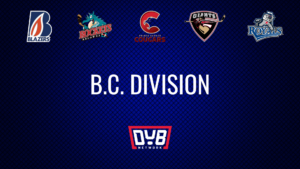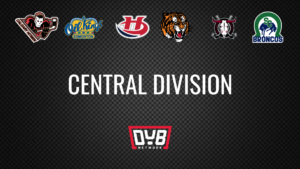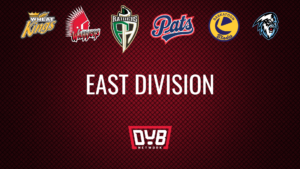The Portland Winterhawks’ 68-game schedule is half complete, and I’ve taken a glance at the numbers to spot anything which catches my eye. My goal is to provide information beyond what someone could quickly view on the season statistics page.
For this report I only included active roster skaters. Any player no longer on the team whether by trade, release, or any other reason are not included.
I also didn’t include Shane Farkas or Dante Giannuzzi in the numbers portion of this review.
Due to limited sample size, Tyson Kozak’s numbers are not included either.
Later in my report, I hand out mid-season awards, biggest surprises, and opportunities heading into the second half of the season.
A first glance at the main statistics broken down by age:
| Age | Number of Players | Goals | Assists | Points | Plus/Minus |
| 16 | 3 | 13 | 19 | 32 | -6 |
| 17 | 5 | 27 | 40 | 67 | 9 |
| 18 | 5 | 15 | 22 | 37 | 25 |
| 19 | 5 | 44 | 86 | 130 | 19 |
| 20 | 3 | 39 | 70 | 109 | 13 |
| Grand Total | 21 | 138 | 237 | 375 | 60 |
| Age | Number of Players | Power Play Goals | Power Play Assists | Game Winning Goals | Short-handed Goals | Short-handed Assists |
| 16 | 3 | 3 | 3 | 1 | 0 | 0 |
| 17 | 5 | 3 | 8 | 5 | 2 | 0 |
| 18 | 5 | 1 | 2 | 1 | 0 | 0 |
| 19 | 5 | 23 | 32 | 6 | 2 | 5 |
| 20 | 3 | 14 | 40 | 5 | 3 | 1 |
| Grand Total | 21 | 44 | 85 | 18 | 7 | 6 |
16’s – Fromm-Delorme, Hanas, Jarvis
17’s – Dureau, Hanus, Newkirk, Nolan, Perna
18’s – Cicek, Delorme, Kvasnica, Ludvig, Mannek
19’s – Gilliss, Glass, Gricius, Hughes, Quigley
20’s – Blichfeld, De Jong, Freadrich
Goals
When I reviewed the first 19 games, the Winterhawks were on pace to score 268 goals this season. After 34 games, if Portland were to keep the same pace, this number would increase to 276; two more than the team scored in 2017-2018. However, the schedule was four games longer last year.
As Andy Kemper tweeted, Team Historian for the Portland Winterhawks, the Winterhawks scored five more goals through 34 games this season compared to last year.
Through 19 games the Winterhawks were averaging 3.95 goals per game, but have picked up the pace to 4.06.
In my last review, Joachim Blichfeld, Cody Glass, and Reece Newkirk accounted for 48% of the team’s goals. When adding Jake Gricius to the fold, the number increased to 60%. Now the percentages are 44% and 54% respectively.
Mike Johnston spoke frequently throughout the first half of the season about the importance of depth scoring as well as player’s bearing down in front of the net. Several players saw a significant increase in production from games 20-34 compared to games 1-19.
17-year-old rookie Jaydon Dureau through 19 games had two goals; after 34, he has seven. His goals per game increased from 0.11 to 0.21.
18-year-old Czech Republic import Michal Kvasnica has also picked up his game lately. With only one goal through the team’s first 19 games, Kvasnica tallied three goals in the next 15 games. While the numbers are not overly impressive, they are trending in the correct direction.
The depth scoring continues with Cross Hanas. The Texas native now boasts five goals during his rookie campaign, including a spectacular goal against Victoria.
2017 first-round bantam pick Seth Jarvis has doubled his goals since I reviewed the numbers previously. Now with six on the campaign, he has two more goals than Skyler McKenize did during his 16-year-old season.
Reece Newkirk though continues to be the biggest catalyst for producing goals outside of Cody Glass and Joachim Blichfeld. The argument of “Newkirk is only scoring because of playing with Glass” is quickly losing ground to stand on. Now with 17 goals, nine have been assisted by anyone other than Glass. After his first 12 goals, seven were assisted by the captain; therefore, four of Reece’s last five goals have been from someone else on the roster.
Of the team’s first 75 goals, 63% were scored by 19 and 20-year-olds. At the holiday break, 60% of the 138 goals are credited to the eight players born in 1998 or 1999.
Blichfeld continues to be the driving force behind this number, and actually picked up his goal-scoring pace during the most recent 15 game stretch. With 31 goals in 34 games, the import from Denmark leads the WHL in goals; three more than Prince Albert’s Brett Leason.
Newkirk still holds the team lead in game-winning goals with four, but Blichfeld, Gricius, and Hughes are only one behind. Nine Winterhawks have at least one game-winning goal, and the list doesn’t include Cody Glass.
Assists
On every scoring play there is an opportunity for two assists to be awarded; therefore, a total of 276 possible assists are available on Portland’s 138 goals. With half the season completed, Portland has 237 assists across all players; good for 86% of the available amount. When compared to the first 19 games, the percentage increased from 84%, but is still slightly less last year’s 87%.
1998 and 1999 born players accounted for 72% of the assists in my last review, and the number has decreased to 66%. Every other age group increased their share of the team’s assists:
- 16-year-olds: 6% to 8%
- 17-year-olds: 13% to 17%
- 18-year-olds: 8.73% to 9.28%
As expected, Blichfeld and Glass are the highest contributors of assists with 76 combined. However, the team relied less on the duo during games 20-34 (32% of total) than they did games 1-19 (39% of total).
Jared Freadrich continues to lead Winterhawk defensemen in assists with 23, but his pace slightly decreased from earlier in the year. Previously on target for 57, the overage defenseman now is trending towards 46. If he ended the year with 46 assists, it would be nearly double his 25 as an 18-year-old with Red Deer and Regina.
Jake Gricius more than doubled his assists per game from 0.21 per game to 0.44. After 19 games the 19-year-old had four; now after 34 games, Gricius has 15.
Another player who more than doubled his assists per game is 2019 NHL draft eligible defenseman Clay Hanus. After only three assists in his first 19 games, the Minnetonka, Minnesota native picked up eight in the last 15 games.
Ryan Hughes’ production in the assist category is also of note going from 0.32 per game to 0.44. He has seven assists in his last ten games, after only four the previous ten.
Plus/Minus
Most are familiar with this statistic, but to be clear: a player earns a “plus” if they are on the ice for a goal scored at even strength or when a shorthanded goal is scored by their team. A player receives a “minus” if they are on the ice for a goal against at even strength or when a shorthanded goal is scored by their opponent. Being on the ice for a power-play goal for or against doesn’t impact a player’s plus/minus.
Many in the hockey community feel this statistic isn’t the best representation of a player given how many variables factor into this statistic. A player could just be jumping on or off the bench when a goal is scored, meaning they have no involvement in the goal. The player could also not be responsible for either the breakdown on defense or the offensive zone time on an offensive zone shift. However, until a better statistic is provided and available, I will continue to view this statistic.
Looking at the plus/minus stats, you expect to see Blichfeld (+17) and Glass (+16) near the top given their offensive abilities. They are currently second and third on the team respectively. John Ludvig, perhaps one of the most under-the-radar players, leads the Winterhawks with a +21 rating. Blichfeld calls him “steel door” because “nothing gets by him”. Blocked shots are not a publicly available statistic, but I can say with extreme confidence Ludvig leads the team.
After trailing Blichfeld in the plus/minus column by one, and even with Glass, after 19 games, the 18-year-old Ludvig now holds the team lead by four. Ludvig showed his defensive ability throughout the first half of the season, and had to earn his rating on the defensive side of the puck. He is often relied upon to defend against the other team’s top line. Also, with 11 points through 34 games, he isn’t hiding behind crazy offensive numbers either.
Each age group increased their plus/minus over the last 15 games:
- 16-year-olds: -8 to -6
- 17-year-olds: -5 to 9
- 18-year-olds: 17 to 25
- 19-year-olds: 3 to 19
- 20-year-olds: 12 to 13
The 17’s and 19’s saw the biggest jump thanks to the following players:
- Dureau: 2 to 9
- Gricius: -6 to even
- Quigley: even to 8
- Glass: 9 to 16
I commented after the first quarter of the season how close to even the 19-year-old age group was performing. Collectively, they have picked up the pace to a much more respectable +19.
As of the last report about half the team was in the positive, while the other half were even or negative. The trend continues with 11 players positive, three even, and seven negative.
Power Play Statistics
At the holiday break the Winterhawks’ power play is third in the WHL operating with a 27.2% efficiency rate. The Spokane Chiefs (28.4%) and Moose Jaw Warriors (28.7%) are the only teams with a higher percentage success rate than Portland.
The success rate of the power play is the exact same as it was after the first 19 games. Over their last five games the power-play conversion is 4/18 (22.2%). Worth noting though, the power play is currently in a stretch of not scoring on their last seven attempts.
While Portland is third on converting their power plays into power-play goals, they lead the league in power-play opportunities (162) and power-play goals (44).
Joachim Blichfeld and Jake Gricius share the team lead in power-play goals with 11 each. They are tied for second with Jake Leschyshyn (Lethbridge) and Mark Kastelic (Calgary). All four players are trailing Stelio Mattheos (Brandon) who has scored 13.
Power-play assists continue to be an area of strength for Portland. Cody Glass leads the entire WHL with 21 while Blichfeld is tied for third with 18. Jared Freadrich is tied for second in the WHL for power-play assists from defensemen with 15. Only Calen Addison (Lethbridge) has more assists on the man advantage with 19.
While exact ice time isn’t available, Portland typically plays their top power play unit of Glass, Blichfeld, Gricius, Hughes, and Freadrich for the majority of the power play. The second unit consisting of Newkirk, Cross Hanas, Jarvis, Gilliss, and Brendan De Jong do not see as much time. Clay Hanus and Mason Mannek also rotate through the second power play unit.
Penalty Kill and Shorthanded Goals
Portland is currently third in the WHL in penalty kill percentage with 85.1% of penalties successfully killed. The Winterhawks’ improved this number from 83.6% after 19 games. Prince Albert leads the league in PK% with 89.5%.
Similar to Portland leading the league in power-play opportunities, they also lead the league in times short-handed with 174.
The coaching staff continues to emphasize limiting the number of penalties per game. After 19 games, on average, they were short-handed just over five times per game. Through 34 games the trend continues as the team averages 5.11 short-handed opportunities per game.
Despite being short-handed the most, the Winterhawks continue to be in the middle of the pack in power-play goals against allowing 26 on the year so far. For perspective, the Prince Albert Raiders have only allowed 17 power-play goals. On the other end of the spectrum, the Regina Pats’ 50 power-play goals allowed is ten higher than the next closest team (Kootenay ICE with 40).
Portland’s seven short-handed goals scored ranks them third in the WHL, and best in the Western Conference. Blichfeld leads the team with three while Glass and Newkirk each have two.
Jake Gricius has proven to be the set-up man while shorthanded. His three short-handed assists leads the team and is tied for the league lead.
Goaltending
The goaltending is a hot-topic and a polarizing one in Portland. Shane Farkas started all but two games for the Winterhawks. Backup Dante Giannuzzi’s two starts came on the road in Seattle and Spokane. The 16-year-old saw game action in two additional games when he replaced Farkas.
Farkas is second in the league behind Everett’s Dustin Wolf in minutes played by goalies.
Below is a breakdown of the splits between starter and backup across the league. These numbers include when a goalie saw any game action, not just starts.
| Team | Points | Standings in Division | Starter Game Appearances | Backup Game Appearances |
| Brandon | 36 | East – 4th | 24 | 8 |
| Calgary | 34 | Central – 5th | 20 | 16 |
| Edmonton | 42 | Central – 3rd | 24 | 15 |
| Everett | 56 | U.S. – 1st | 34 | 5 |
| Kamloops | 27 | B.C. – 4th | 23 | 14 |
| Kelowna | 34 | B.C. – 2nd | 24 | 14 |
| Kootenay | 22 | Central – 6th | 21 | 18 |
| Lethbridge | 42 | Central – 2nd | 24 | 12 |
| Medicine Hat | 37 | Central – 4th | 19 | 18 |
| Moose Jaw | 39 | East – 3rd | 16 | 15 |
| Portland | 42 | U.S. – 2nd | 32 | 4 |
| Prince Albert | 63 | East – 1st | 26 | 9 |
| Prince George | 25 | B.C. – 5th | 25 | 12 |
| Red Deer | 42 | Central – 1st | 27 | 7 |
| Regina | 19 | East – 5th | 27 | 14 |
| Saskatoon | 46 | East – 2nd | 29 | 8 |
| Seattle | 26 | U.S. – 5th | 26 | 6 |
| Spokane | 42 | U.S. – 3rd | 22 | 15 |
| Swift Current | 14 | East – 6th | 25 | 8 |
| Tri-City | 36 | U.S. – 4th | 29 | 3 |
| Vancouver | 46 | B.C. – 1st | 20 | 14 |
| Victoria | 33 | B.C. – 3rd | 23 | 9 |
A quick glance at the goalie ages for teams where the backup appeared in less than ten games is below. An interesting observation is Tri-City is the only other team with a 16-year-old backup on this list. (Note: Kamloops’ Dylan Garrand is the only other 16-year-old backup in the league. Garrand appeared in 12 of his team’s first 31 games.
| Team | Starter’s Age | Backup’s Age |
| Brandon | 19 | 17 |
| Everett | 17 | 18 |
| Portland | 19 | 16 |
| Prince Albert | 19 | 18 (17 y/o has one GP) |
| Red Deer | 18 | 17 |
| Saskatoon | 17 | 19 |
| Seattle | 19 | 17 |
| Swift Current | 18 | 17 |
| Tri-City | 19 | 16 |
| Victoria | 20 | 17 |
Biggest Surprises
Handing out the biggest surprises of the season so far was a challenge, but will do so in the form of three stars.
I’m cheating for my third star, and say the play of the three rookie defensemen rotating in-and-out of the lineup. Nick Perna, Kade Nolan, and Nick Cicek each bring something different when they are in the lineup. The trio is not providing much in terms of support on the scoresheet, but have not looked out of place playing on the third playing when called upon. I’ve been impressed by Nolan’s game as of late, but Perna and Cicek are solid defenders for the Winterhawks as well.
Second star in terms of biggest surprise is awarded to Jared Freadrich. Teams often rely on overage players to be key players. Freadrich has provided a much needed lift to Portland after being acquired in the off-season. Tasked with quarterbacking the first power play unit, Jared distributed the puck well during the first half of the year. As the season progressed teams keyed on stopping the Blichfeld one-timer, and Jared kept teams honest with his shooting ability. As the team’s only right-shot defenseman, Freadrich continues to limit the long shifts in the defensive zone with his capability to execute the breakout.
Reece Newkirk earns the first star without question. The 17-year-old took a massive step forward from his rookie season. Already surpassing last season’s totals in points and assists, the draft eligible forward provided much needed scoring depth. Newkirk proved he could play top line minutes with Glass and Blichfeld along with moving around the lineup playing with younger players as well. Part of Reece’s flexibility is playing the wing when with the top line, but centering other lines. His offensive pace slowed slightly over the last 15 games. However, the chemistry developed between what I’m calling “The Futures” line of Dureau, Jarvis, and Newkirk. This line created opportunities and chances every game.
Biggest Opportunities
I once again challenge the 19-year-old group to take yet another step forward. Ryan Hughes and Jake Gricius stepped up while Glass is away at World Juniors. They will need to continue to take steps forward if Portland is to make a run in the playoffs. Gilliss and Matt Quigley need to continue to provide leadership for their respective areas and lead the charge defensively. Any offense from these two is a massive bonus.
Dare I provide a challenge to Glass; shoot the puck with greater frequency. Teams, and especially goalies, are keying on the pass to Blichfeld. While his best attributes are his passing ability and vision, getting the puck on net will only create more opportunities. After all, he scored 37 goals last season, so the shot is there.
I also look towards Michal Kvasnica to continue to improve on his game. The bigger-body import started to use his size and strength over the last six games. He is scoring more often, but am also seeing the chances arise with greater frequency. Two posts and a breakaway for Kvasnica in the games against Tri-City before the break shows the North American style game is starting to show in his game.
I’ve heard plenty of criticism of goalie Shane Farkas, but I am not ready to cast him aside. The backup goalie on a hockey team is often the favorite player. Last season Farkas’ second half of the season included back-to-back shutouts of a Tri-City team who swept their first two rounds of the playoffs. Based upon Shane’s play towards the end of the year, many were calling for him to start game one of the playoffs. Farkas’ save percentage this season is an even 0.900 vs. 0.913 a season ago. If he is able to return to where he was a calendar year prior, the Winterhawks could make a run.
Midseason Awards
Top rookie – Seth Jarvis with honorable mention to Jaydon Dureau
Top Defenseman – John Ludvig with honorable mention to Jared Freadrich
MVP – Joachim Blichfeld with honorable mention to Cody Glass
Overall
The Winterhawks continue to be paced by Cody Glass and Joachim Blichfeld. With the trade deadline fast approaching, January 10th, Portland is in a key stretch of games. The Winterhwaks have seven games on their schedule before the trade deadline; five of which are on the road. This year’s deadline occurs in the middle of the Winterhawks road trip to play against one of the Eastern Conference’s divisions. This year, Portland faces the East Division on the road and plays host to the Central.
The power play has been a crutch for Portland throughout the season. During the first 19 games of the season 37% of the team’s goals came via the power play. 5-on-5 scoring continues to be a priority for head coach Mike Johnston. After 34 games 32% of Portland’s goals are now courtesy of the man advantage.
Portland’s 42 points is good for a tie for second place in the U.S. Division with the Spokane Chiefs. Both teams hold a six point advantage over Tri-City; however, the Americans have three games in hand. Should they win those games, there would be a three-way tie for second in the division.
Vancouver sits atop the B.C. Division with 46 points, and two games in hand on Portland. While the Winterhawks won both games in October; a lot has changed since games ten and eleven. Vancouver is 8-2 in their last ten games and allowed the fewest goals (70) in the Western Conference.
Everett’s first half of the year has been dominant; possibly overshadowed a little by what Prince Albert is doing out east. The Silvertips have points in their last 14 games, and their last regulation loss was all the way back on November 16th. Everett leads the division by 14 points, playing two more games than Portland & Spokane, and five more than Tri-City. Everett leads the season series after winning five of the seven games. The games have been relatively close, with the Silvertips outscoring the Winterhawks 22-18 in the seven contests.
I do not see Portland catching Everett for the division unless a major move is made by the Winterhawks and/or a key injury happens to the Silvertips. Spokane spent the first half of the season without 19-year-old star player Jaret Anderson-Dolan (with the exception of two games), but he is scheduled to play for Team Canada at the upcoming World Junior Championships starting December 26th. The impact Anderson-Dolan provides the Chiefs, along with each team’s trade deadline acquisitions, will most likely determine who has home ice in the first round of the playoffs.
The Winterhawks play 15 games at home and 19 on the road in the second half of the season.
I will examine again once the team reaches the 3/4 mark of the season (after February 2nd’s game against Spokane).




